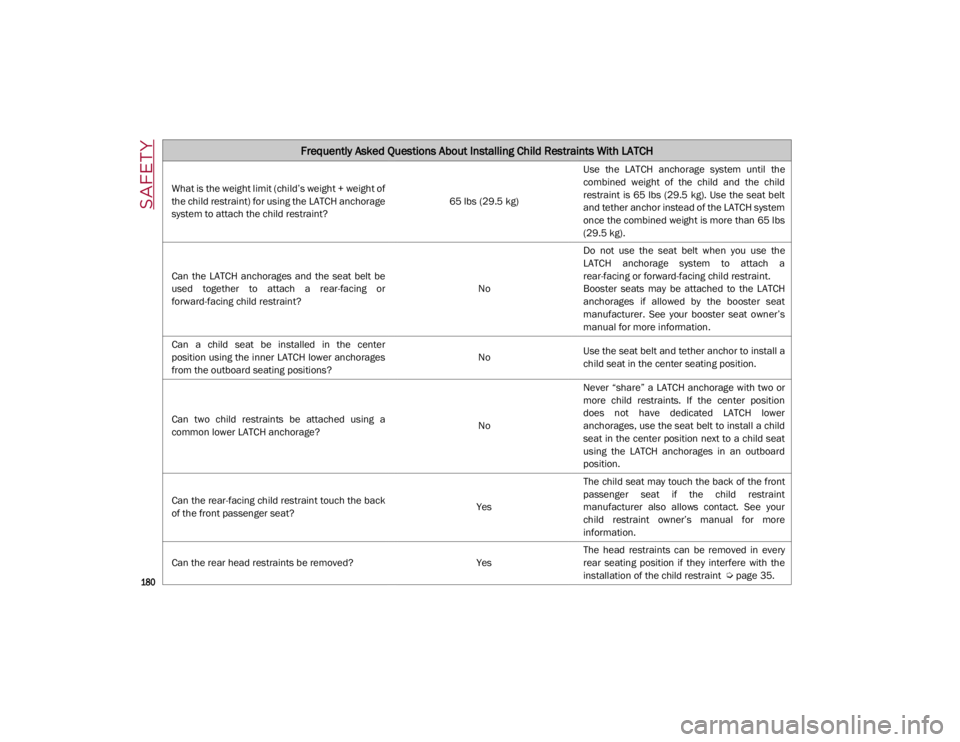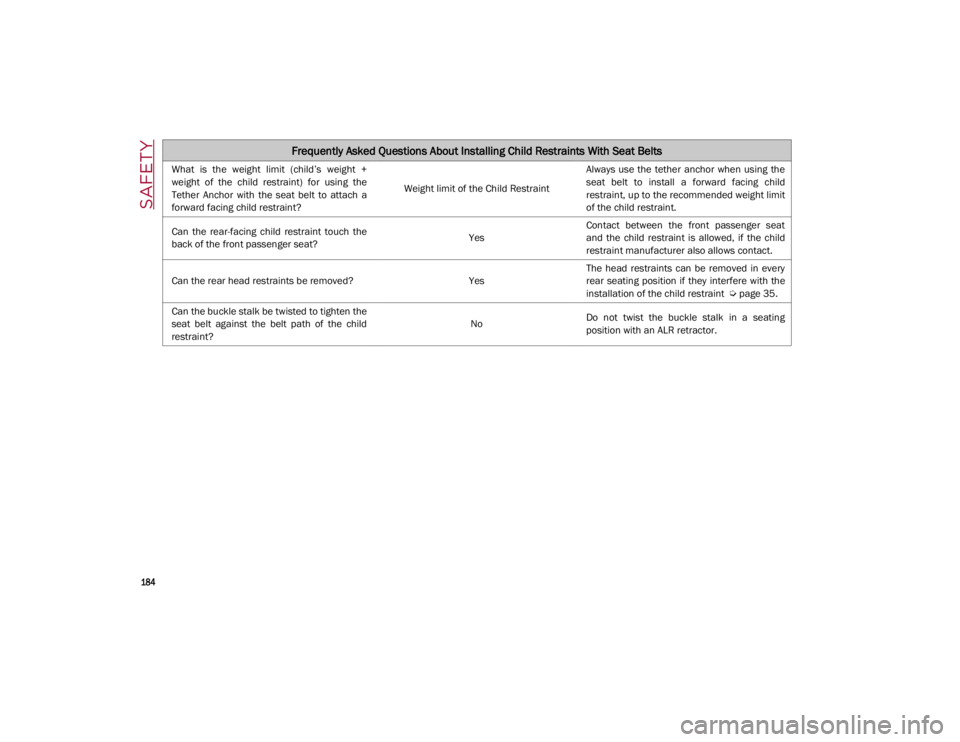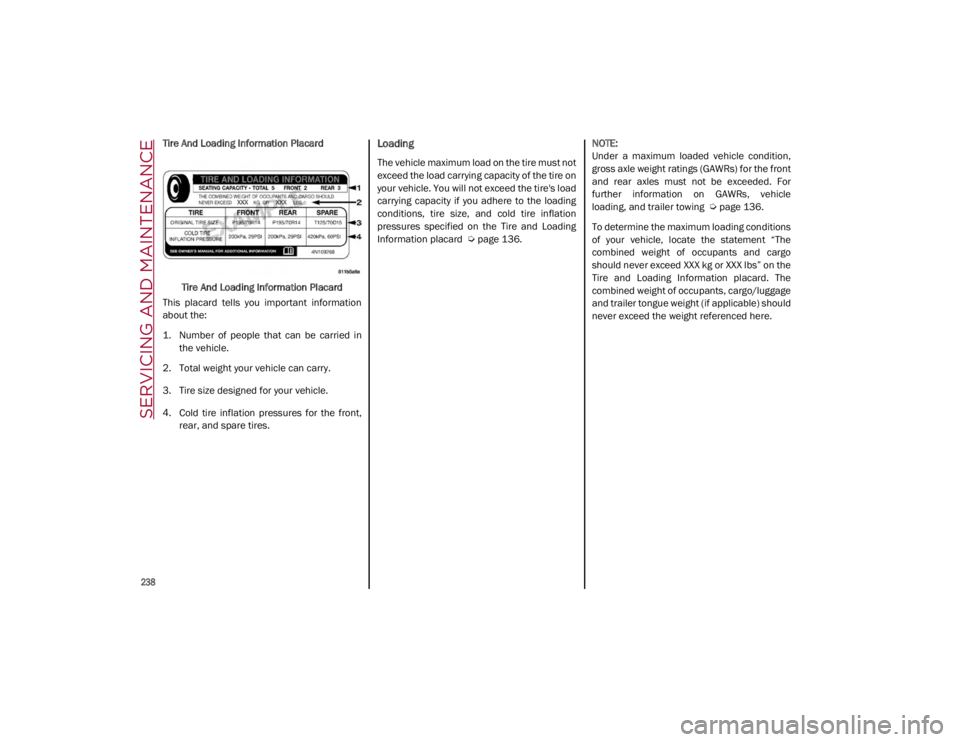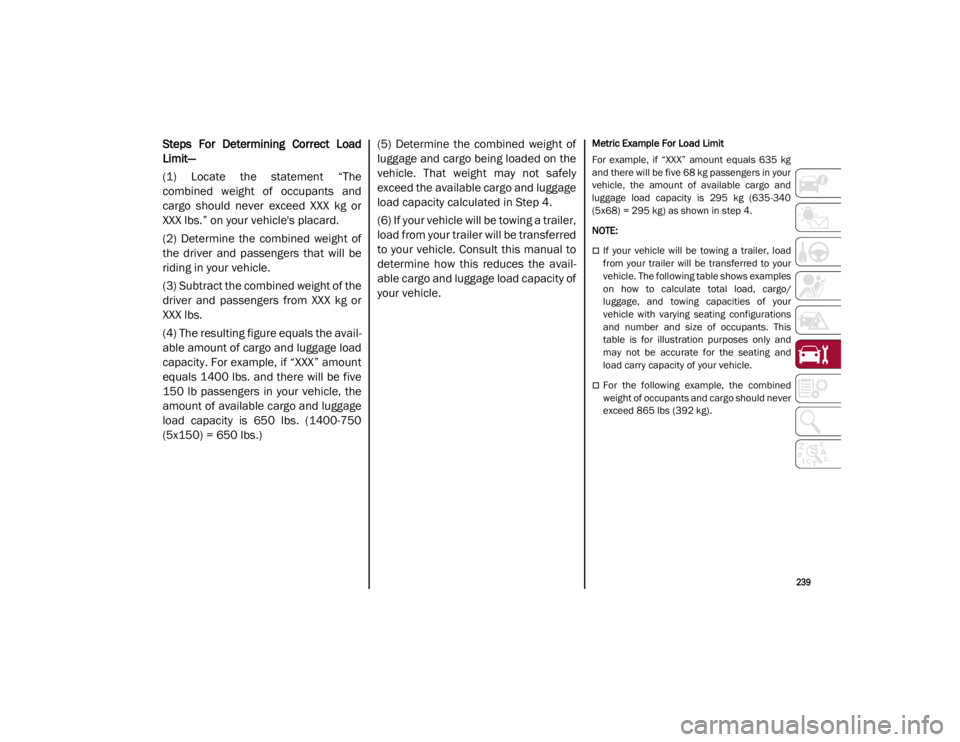2021 ALFA ROMEO GIULIA weight
[x] Cancel search: weightPage 182 of 284

SAFETY
180
Frequently Asked Questions About Installing Child Restraints With LATCH
What is the weight limit (child’s weight + weight of
the child restraint) for using the LATCH anchorage
system to attach the child restraint? 65 lbs (29.5 kg)Use the LATCH anchorage system until the
combined weight of the child and the child
restraint is 65 lbs (29.5 kg). Use the seat belt
and tether anchor instead of the LATCH system
once the combined weight is more than 65 lbs
(29.5 kg).
Can the LATCH anchorages and the seat belt be
used together to attach a rear-facing or
forward-facing child restraint? NoDo not use the seat belt when you use the
LATCH anchorage system to attach a
rear-facing or forward-facing child restraint. Booster seats may be attached to the LATCH
anchorages if allowed by the booster seat
manufacturer. See your booster seat owner’s
manual for more information.
Can a child seat be installed in the center
position using the inner LATCH lower anchorages
from the outboard seating positions? No
Use the seat belt and tether anchor to install a
child seat in the center seating position.
Can two child restraints be attached using a
common lower LATCH anchorage? NoNever “share” a LATCH anchorage with two or
more child restraints. If the center position
does not have dedicated LATCH lower
anchorages, use the seat belt to install a child
seat in the center position next to a child seat
using the LATCH anchorages in an outboard
position.
Can the rear-facing child restraint touch the back
of the front passenger seat? YesThe child seat may touch the back of the front
passenger seat if the child restraint
manufacturer also allows contact. See your
child restraint owner’s manual for more
information.
Can the rear head restraints be removed? YesThe head restraints can be removed in every
rear seating position if they interfere with the
installation of the child restraint
Ú
page 35.
21_GA_OM_EN_USC_t.book Page 180
Page 186 of 284

SAFETY
184
Frequently Asked Questions About Installing Child Restraints With Seat Belts
What is the weight limit (child’s weight +
weight of the child restraint) for using the
Tether Anchor with the seat belt to attach a
forward facing child restraint? Weight limit of the Child RestraintAlways use the tether anchor when using the
seat belt to install a forward facing child
restraint, up to the recommended weight limit
of the child restraint.
Can the rear-facing child restraint touch the
back of the front passenger seat? YesContact between the front passenger seat
and the child restraint is allowed, if the child
restraint manufacturer also allows contact.
Can the rear head restraints be removed? YesThe head restraints can be removed in every
rear seating position if they interfere with the
installation of the child restraint
Ú
page 35.
Can the buckle stalk be twisted to tighten the
seat belt against the belt path of the child
restraint? No
Do not twist the buckle stalk in a seating
position with an ALR retractor.
21_GA_OM_EN_USC_t.book Page 184
Page 240 of 284

SERVICING AND MAINTENANCE
238
Tire And Loading Information PlacardTire And Loading Information Placard
This placard tells you important information
about the:
1. Number of people that can be carried in the vehicle.
2. Total weight your vehicle can carry.
3. Tire size designed for your vehicle.
4. Cold tire inflation pressures for the front, rear, and spare tires.Loading
The vehicle maximum load on the tire must not
exceed the load carrying capacity of the tire on
your vehicle. You will not exceed the tire's load
carrying capacity if you adhere to the loading
conditions, tire size, and cold tire inflation
pressures specified on the Tire and Loading
Information placard
Ú
page 136.
NOTE:
Under a maximum loaded vehicle condition,
gross axle weight ratings (GAWRs) for the front
and rear axles must not be exceeded. For
further information on GAWRs, vehicle
loading, and trailer towing
Ú
page 136.
To determine the maximum loading conditions
of your vehicle, locate the statement “The
combined weight of occupants and cargo
should never exceed XXX kg or XXX lbs” on the
Tire and Loading Information placard. The
combined weight of occupants, cargo/luggage
and trailer tongue weight (if applicable) should
never exceed the weight referenced here.
21_GA_OM_EN_USC_t.book Page 238
Page 241 of 284

239
Steps For Determining Correct Load
Limit—
(1) Locate the statement “The
combined weight of occupants and
cargo should never exceed XXX kg or
XXX lbs.” on your vehicle's placard.
(2) Determine the combined weight of
the driver and passengers that will be
riding in your vehicle.
(3) Subtract the combined weight of the
driver and passengers from XXX kg or
XXX lbs.
(4) The resulting figure equals the avail-
able amount of cargo and luggage load
capacity. For example, if “XXX” amount
equals 1400 lbs. and there will be five
150 lb passengers in your vehicle, the
amount of available cargo and luggage
load capacity is 650 lbs. (1400-750
(5x150) = 650 lbs.) (5) Determine the combined weight of
luggage and cargo being loaded on the
vehicle. That weight may not safely
exceed the available cargo and luggage
load capacity calculated in Step 4.
(6) If your vehicle will be towing a trailer,
load from your trailer will be transferred
to your vehicle. Consult this manual to
determine how this reduces the avail
-
able cargo and luggage load capacity of
your vehicle.Metric Example For Load Limit
For example, if “XXX” amount equals 635 kg
and there will be five 68 kg passengers in your
vehicle, the amount of available cargo and
luggage load capacity is 295 kg (635-340
(5x68) = 295 kg) as shown in step 4.
NOTE:
If your vehicle will be towing a trailer, load
from your trailer will be transferred to your
vehicle. The following table shows examples
on how to calculate total load, cargo/
luggage, and towing capacities of your
vehicle with varying seating configurations
and number and size of occupants. This
table is for illustration purposes only and
may not be accurate for the seating and
load carry capacity of your vehicle.
For the following example, the combined
weight of occupants and cargo should never
exceed 865 lbs (392 kg).
21_GA_OM_EN_USC_t.book Page 239
Page 257 of 284

255
For the enthusiasts, the technician, or those
who just want to know every detail of their
vehicle, useful information on understanding
how your vehicle works is contained in this
chapter and illustrated with data, tables, and
graphics.VEHICLE IDENTIFICATION
NUMBER (VIN)
The VIN is stamped on a plate on the front left
corner of the dashboard cover, which can be
seen from outside the vehicle, through the
windshield.Windshield VIN Location
Vehicle Identification Number (VIN) Plate
The plates are located on the left side A-pillar
and contain the data about:
Vehicle Identification Number (VIN).
Vehicle type (USA and Canada only).
Color code.
Place of manufacturing of the vehicle (USA
and Mexico only).
Vehicle manufacturing date.
Maximum permitted weights.
Permitted tire inflation pressure (USA and
Canada only).
21_GA_OM_EN_USC_t.book Page 255
Page 264 of 284

TECHNICAL SPECIFICATIONS
262
WEIGHTS — 2.0L ENGINE
WEIGHTS — 2.9L ENGINE
Weights (lbs)AWDRWD
Unloaded weight (with all fluids, fuel tank filled to 90% and without
optional equipment) 3,622
3,522
Payload including the driver
1
1. If special equipment is fitted (trailer towing equipment, etc.) the empty weight will increase and consequently the payload will decrease in relation to the maximum permitted loads.
905 905
Maximum permitted loads
2
2. Loads not to be exceeded. The user is responsible for arranging goods in the luggage compartment and/or on the load platform within the maximum permitted loads.
155 155
Front axle 2,2052,205
Rear axle 2,6462,646
Total 4,7234,612
Weights (lbs)2.9L Engine
Unloaded weight (with all fluids, fuel tank filled to 90% and without
optional equipment) 3,820
Payload including the driver
1
1. If special equipment is fitted (trailer towing equipment, etc.) the empty weight will increase and consequently the payload will decrease in relation to the maximum permitted loads.
905
Maximum permitted loads
2
2. Loads not to be exceeded. The user is responsible for arranging goods in the luggage compartment and/or on the load platform within the maximum permitted loads.
155
Front axle 2,260
Rear axle 2,646
Total 4,774
21_GA_OM_EN_USC_t.book Page 262
Page 280 of 284

278
INDEX
T
Tie Down Hooks, Cargo ................................ 64
Tire And Loading Information Placard ......237
Tire Markings..............................................234
Tire Safety Information .............................. 234
Tire Service Kit ...........................................194
Tires .................................188, 241, 246, 250Aging (Life Of Tires) ................................ 245Air Pressure ............................................ 241
Flat Changing .........................................194
General Information......................241, 246
High Speed ............................................. 242
Inflation Pressure...................................241Life Of Tires ............................................ 245
Load Capacity................................237, 238Pressure Monitoring System (TPMS) .............................. 75, 76
Quality Grading....................................... 250
Radial......................................................244
Replacement ..........................................245
Safety .............................................234, 241
Sizes .......................................................234
Snow Tires ..............................................247
Spare Tires ............................................. 246
Spinning..................................................244
Tread Wear Indicators ...........................244
Tow Hooks ..................................................202 Towing
Disabled Vehicle .................................... 201
Towing Trailers ........................................... 138
TPMS (Tire Pressure Monitoring
System) ....................................................... 156
Traction Control System (TCS) .................. 144
Transmission .............................................. 258
Transporting Animals................................. 139
Transporting Passengers .......................... 139
Transporting Pets....................................... 187
Tread Wear Indicators ............................... 244
Trunk Lid (Deck Lid) ..................................... 63
Turn Signals ...........................................44, 77
U
Uconnect Settings Customer Programmable Features ........ 24
Passive Entry Programming .................... 24
Uniform Tire Quality Grades ...................... 250
Universal Transmitter .................................. 38
Untwisting Procedure, Seat Belt ............... 162
Use Of The Owner’s Manual........................... 5
V
Vehicle Changes/Alterations ......................... 3
Vehicle Identification Number .................. 255
Vehicle Loading ................................. 136, 238 W
Warning Lights (Instrument Cluster
Descriptions)................................................. 75
Warranty Information ................................ 272
WARRANTY INFORMATION
.................. 272
Washer Fluid For Windshield/
Headlights .................................................. 214
Washers, Windshield.................................... 47
Weights ...................................................... 262
Wheel And Wheel Tire Care ...................... 246
Wheel And Wheel Tire Trim....................... 246
Wheels And Tires ....................................... 234
Wind Buffeting ..............................................59
Windows (Cleaning) ................................... 253
Windshield Defroster ................................ 187
Windshield Washers.....................................47
Windshield Wiper Replacing Blades .................................. 219
Windshield Wipers ........................................46
Wipers, Intermittent .....................................47
Wipers, Rain Sensitive .................................47
21_GA_OM_EN_USC_t.book Page 278